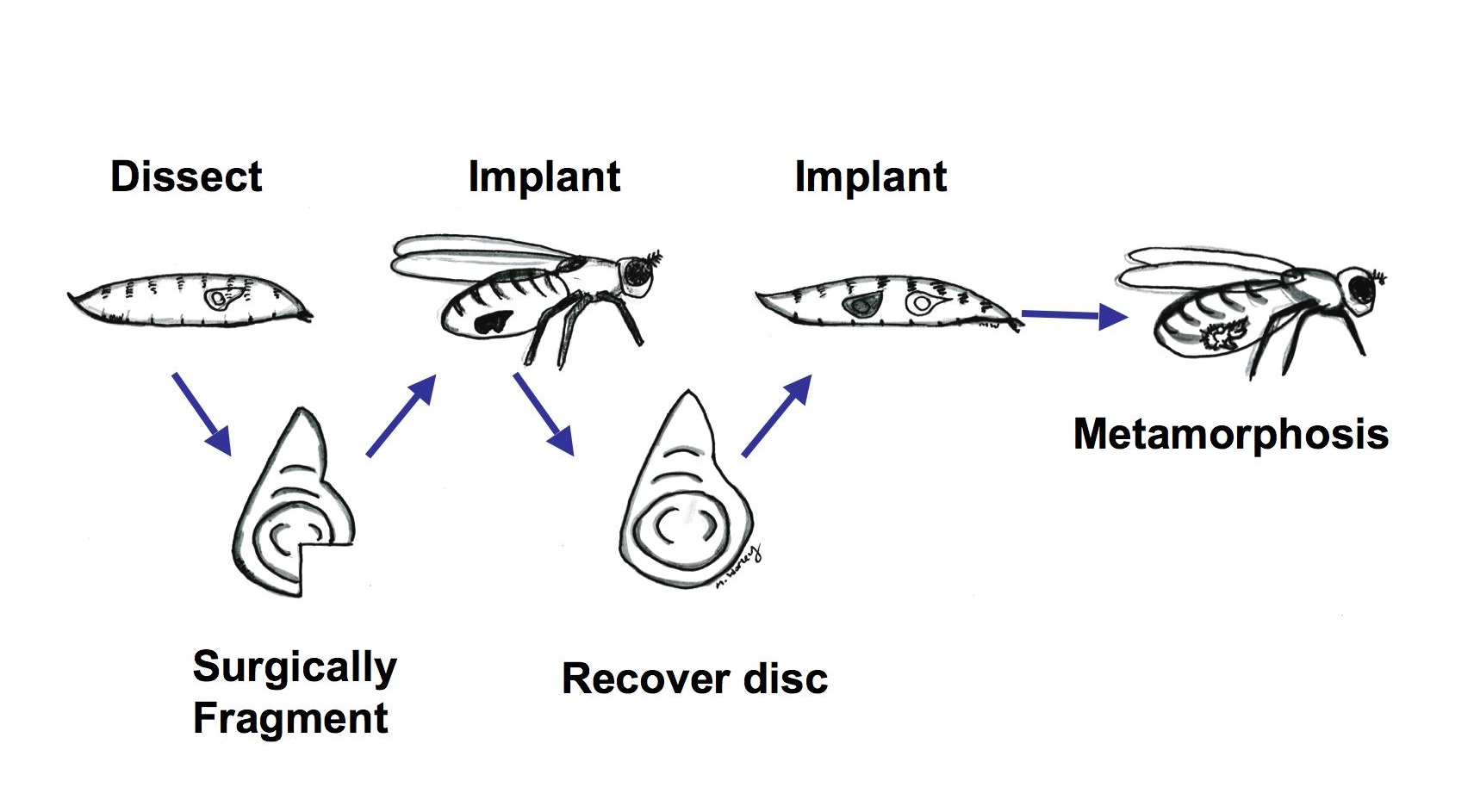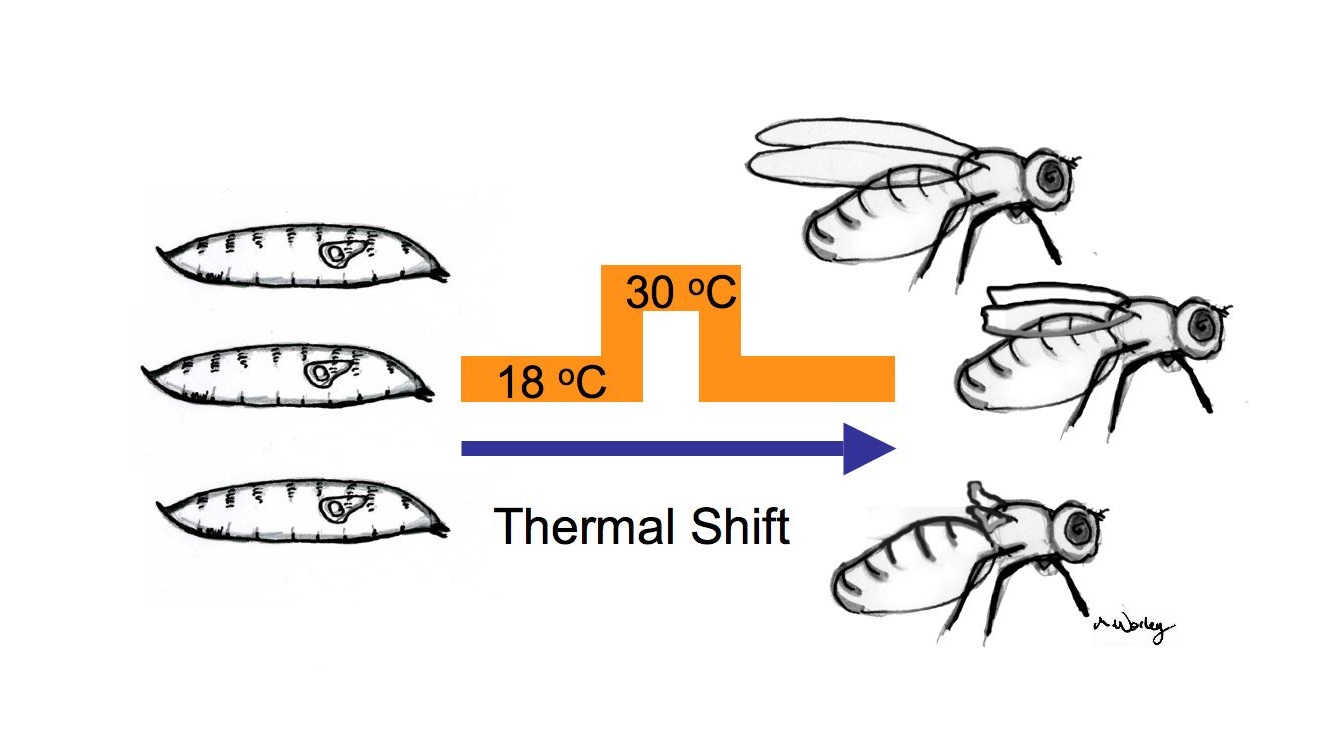

2) Studies of regeneration in Drosophila
(Link to our review on imaginal disc regeneration)
(Link to our 2016 paper on the reduction in regenerative capacity that accompanies tissue maturation)
(Link to our 2016 paper on the role of plexins in wound healing in Drosophila and zebrafish)
The fundamental question in the study of regeneration is why some animals have a remarkable capacity to regenerate damaged tissues while others do not. For instance, while urodele amphibians (salamanders, newts) are capable of regenerating their limbs after amputation, mammalian limbs have very little regenerative capacity. Similarly, in many species, less regenerative capacity is observed in adults than at earlier stages of development. The long term goal of our research is to understand the genetic pathways that regulate the capacity of a tissue for regenerative growth.
The imaginal discs of Drosophila larvae are capable of regenerating missing portions when implanted into the abdomen of adult females. However, these experiments are technically difficult and not easily incorporated into large-scale genetic screens.
 |
 |
| The traditional way of studying imaginal disc regeneration | Our system allows the study of imaginal disc regeneration in situ |
(Drawings by Melanie Worley)
To take advantage of the powerful tools of fly genetics, we have devised a way of studying tissue regeneration in Drosophila that does not require surgical manipulations. Using a temperature shift, we are able to ablate the portion of the larval wing imaginal disc that gives rise to the wing blade of the adult, and to study the ensuing regenerative growth. We can easily score the extent of regeneration by examining the size of the wings of adult flies. Our laboratory is currently using this method to study the properties of regenerative growth and to conduct genetic screens for genes that regulate tissue regeneration.
We have also addressed the mechanism by which tissue damage in larvae delays pupariation. Our studies indicate that tissue damage activates a developmental checkpoint that delays the production of the peptide hormone PTTH. Since PTTH activates the release of ecdysone by the ring gland and promotes metamorphosis, delaying PTTH production extends the larval stage - a condition that is permissive for regenerative growth. Our results point to a role for retinoids in the mechanism that links tissue damage to delayed PTTH production. This masy provide a tractable model for understanding how individual tissues communicate the presence of damage to the entire organism.
An important problem that we have been studying is why organisms typically become less effective at regenerating damaged tissues as they mature. In many instances the tissues that become incapable of regeneration continue to grow and change morphology. Since most, if not all, genes that function during regeneration also have functions during normal growth and morphogenesis, it was not known how regeneration could be selectively inhibited without compromising the function of those same genes in growth and morphogenesis. We have found, that in imaginal discs, that this occurs by localized epigenetic silencing of damage-responsive enhancers. This prevents these genes from being turned on in response to tissue damage but allows those genes to still be expressed in the dynamic patterns that are necessary for growth and morphogenesis via distinct enhancers that respond to developmentally-regulated signals.
Publications:
Smith-Bolton RK, Worley MI, Kanda H, Hariharan IK (2009) Regenerative growth in Drosophila imaginal discs is regulated by Wingless and Myc. Developmental Cell 16:797-809. (PubMed Link)
This work was discussed in a "Preview" published in Developmental Cell by Nachtrab and Poss (PubMed Link)
Halme AJ, Cheng M, Hariharan IK (2010) Retinoids regulate a developmental checkpoint for tissue regeneration in Drosophila. Current Biology 20:458-63. (PubMed Link)
Gerhold AR, Richter DJ, Yu AS, Hariharan IK (2011) Identification and characterization of genes required for compensatory growth in Drosophila. Genetics 189:1309-26. (PubMed Link - this is an Open Access Article)
Harris RE, Setiawan L, Saul J, Hariharan IK (2016) Localized epigenetic silencing of a damage-activated WNT enhancer limits regeneration in mature Drosophila imaginal discs. eLife 5:e11588.(PubMed Link - this is an Open Access Article)
Yoo SK, Pascoe HG, Pereira T, Kondo S, Jacinto A, Zhang X, Hariharan IK (2016) Plexins function in epithelial repair in both Drosophila and zebrafish. Nat. Commun. 7:12282 doi: 10.1038/ncomms12282(PubMed Link - this is an Open Access Article)
Review Articles
Hariharan IK (2012) How growth abnormalities delay "puberty" in Drosophila Science Signaling 5(229):pe27 (PubMed Link)
Worley MI, Setiawan L, Hariharan IK (2012) Regeneration and transdetermination in Drosophila imaginal discs. Annual Review of Genetics. (PubMed Link) (Direct link to article)
| Home | Science | People | Publications | Contact Us |